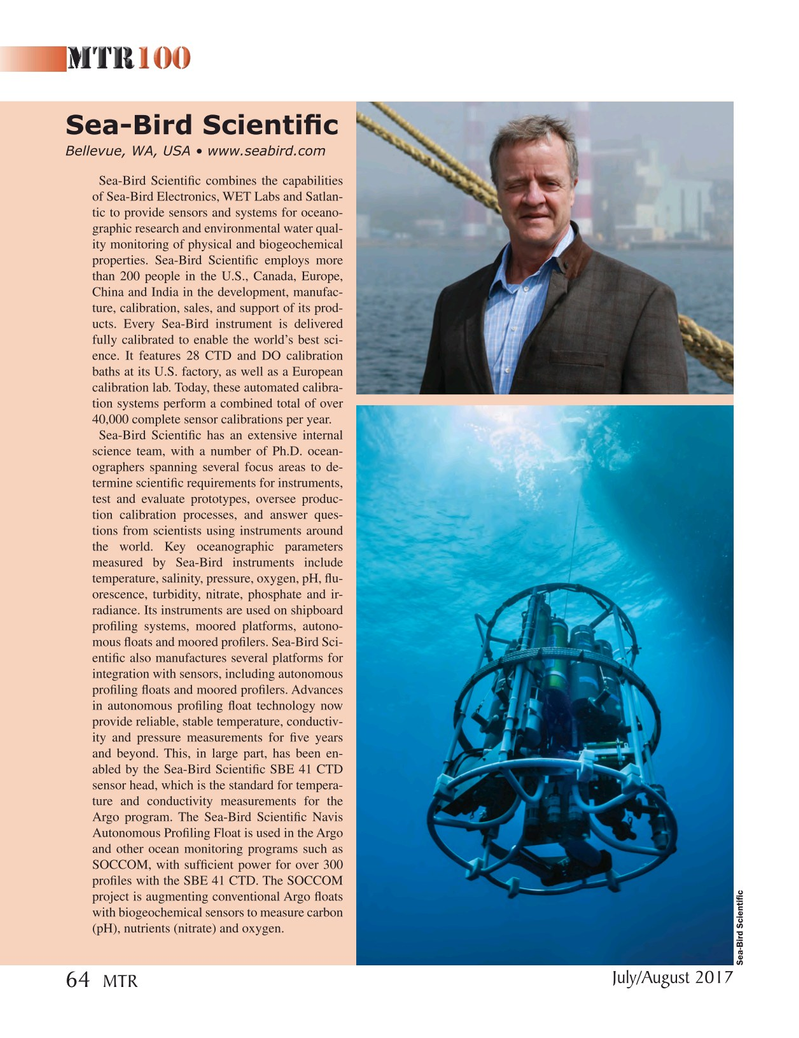
Page 64: of Marine Technology Magazine (July 2017)
THE MTR 100 - 12th Annual Listing of 100 Leading Subsea Companies
Read this page in Pdf, Flash or Html5 edition of July 2017 Marine Technology Magazine
Sea-Bird Scienti? c
Bellevue, WA, USA • www.seabird.com
Sea-Bird Scienti? c combines the capabilities of Sea-Bird Electronics, WET Labs and Satlan- tic to provide sensors and systems for oceano- graphic research and environmental water qual- ity monitoring of physical and biogeochemical properties. Sea-Bird Scienti? c employs more than 200 people in the U.S., Canada, Europe,
China and India in the development, manufac- ture, calibration, sales, and support of its prod- ucts. Every Sea-Bird instrument is delivered fully calibrated to enable the world’s best sci- ence. It features 28 CTD and DO calibration baths at its U.S. factory, as well as a European calibration lab. Today, these automated calibra- tion systems perform a combined total of over 40,000 complete sensor calibrations per year.
Sea-Bird Scienti? c has an extensive internal science team, with a number of Ph.D. ocean- ographers spanning several focus areas to de- termine scienti? c requirements for instruments, test and evaluate prototypes, oversee produc- tion calibration processes, and answer ques- tions from scientists using instruments around the world. Key oceanographic parameters measured by Sea-Bird instruments include temperature, salinity, pressure, oxygen, pH, ? u- orescence, turbidity, nitrate, phosphate and ir- radiance. Its instruments are used on shipboard pro? ling systems, moored platforms, autono- mous ? oats and moored pro? lers. Sea-Bird Sci- enti? c also manufactures several platforms for integration with sensors, including autonomous pro? ling ? oats and moored pro? lers. Advances in autonomous pro? ling ? oat technology now provide reliable, stable temperature, conductiv- ity and pressure measurements for ? ve years and beyond. This, in large part, has been en- abled by the Sea-Bird Scienti? c SBE 41 CTD sensor head, which is the standard for tempera- ture and conductivity measurements for the
Argo program. The Sea-Bird Scienti? c Navis
Autonomous Pro? ling Float is used in the Argo and other ocean monitoring programs such as
SOCCOM, with suf? cient power for over 300 pro? les with the SBE 41 CTD. The SOCCOM project is augmenting conventional Argo ? oats with biogeochemical sensors to measure carbon (pH), nutrients (nitrate) and oxygen.
Sea-Bird Scienti? c
July/August 2017 64
MTR
MTR #6 (50-65).indd 64 MTR #6 (50-65).indd 64 8/2/2017 11:44:27 AM8/2/2017 11:44:27 AM

 63
63

 65
65
